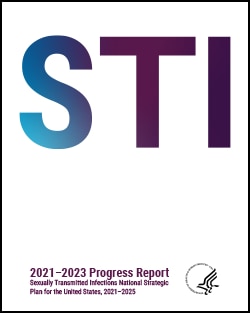The cross-agency work group focused on implementing the STI National Strategic Plan 2021-2025 (STI Federal Implementation Working Group) continues to meet regularly to monitor progress, strategize about overcoming obstacles, and identify and capitalize on new opportunities or address emerging needs. In addition, the STI Federal Implementation Working Group develops progress reports, highlighting select accomplishments in implementing the National Strategic Plan.
2021-2023 Progress Report
The STI Plan establishes seven core indicators to measure progress on meeting its goals. Four of the core indicators are stratified to measure progress toward reducing disparities within priority populations. The indicators were selected to measure national progress on STI prevention and care based on the available data and in alignment with other national plans, for example, Healthy People 2030. The table below presents overall progress for each indicator measure toward 2025 targets, based on the most recently available surveillance data from either 2021 or 2022.
- 2021-2023 Progress Report At a Glance- 2 page overview
- For more details, read the full 2021-2023 Progress Report.

Overall Progress on STI National Strategic Plan Indicators toward 2025 Targets
| Indicator | Status |
|---|---|
| Core Indicators | |
| 1. Increase the percentage of adolescents aged 13–17 years who receive the routinely recommended doses of human papillomavirus (HPV) vaccine to 80% by 2025 | |
| 2. Reduce primary and secondary syphilis (P&S) syphilis rate by 3% by 2025 | |
| 3. Reduce congenital syphilis rate by 15% by 2025 | |
| 4. Reduce gonorrhea rate by 2% by 2025 | |
| 5. Increase chlamydia screening in sexually active females aged 16–24 by 13% by 2025 | |
| 6. Reduce pelvic inflammatory disease (PID) in females aged 15–24 years by 6% by 2025 | |
| 7. Increase condom use at last sexual intercourse among sexually active high school students by 4% by 2025 | |
| Disparities Indicators | |
| 8. Reduce P&S syphilis rate in gay, bisexual, and other men who have sex with men (MSM) | |
| 9. Reduce congenital syphilis rate among African Americans/Blacks | |
| 10. Reduce congenital syphilis rate among American Indians/Alaska Natives | |
| 11. Reduce congenital syphilis rate in the West | |
| 12. Reduce gonorrhea rate among African Americans/Blacks | |
| 13. Reduce gonorrhea rate in the South | |
| 14. Increase condom use at last sexual encounter among sexually active MSM high school students | |
